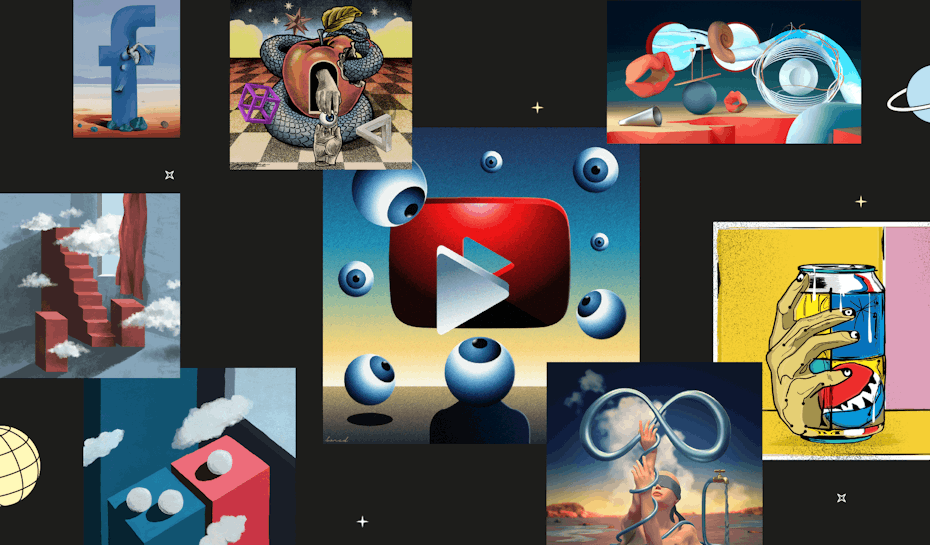It’s been 100 years since European poets André Breton and Yvan Goll published their competing Surrealist Manifestos, pioneering an artistic revolution that embraced alternative perspectives and the weird, wonderful power of the subconscious mind.
Since then, the Surrealist movement has given us some of the most enduring imagery in modern art — from that pipe that’s not a pipe to those famous melting clocks — while its ideas continue to resonate with creatives today.

To celebrate that legacy, we’ve asked our global community of professional freelance designers to reimagine some of today’s most influential brands in the style of Surrealist artists.
Why? Because it’s fun, obviously, and we get to show off the talent and creativity of our designer community. But we also wanted to explore Surrealist themes that have made the movement as relevant today as it was 100 years ago.
What is Surrealism?
—
Surrealism developed in Europe in the aftermath of World War I and the 1918 flu epidemic (sound familiar?), two traumatic global events that led avant-garde thinkers and artists to look for a new approach to the human experience.

It all started in Paris in 1924, when Breton and Goll, the leaders of two rival literary groups, both published a Surrealist Manifesto within two weeks of each other. (At one Surrealist event, philosophical tensions erupted into an actual skirmish.)
But Breton’s side eventually won out. And, in a nutshell, he blamed the struggles of the day on “centuries of rationalism,” advocating instead for the power of “irrational” thought.
Inspired by psychoanalyst Sigmund Freud, Surrealists felt true creative freedom could be found in dreams and the subconscious.
From the 1920s to the 1950s, artists like Salvador Dalí, René Magritte and Joan Miró adopted Surrealist philosophies and techniques to challenge the creative status quo.
They worked to channel their innermost thoughts into bizarre, subversive and fantastical works of art, often depicting dream-worlds, distorted figures and alternate realities.
Now, a century later, we’re dealing with social and political forces that 20th century Surrealists might have found eerily recognizable: yet another deadly global pandemic, widespread geo-political conflict and sweeping technological change.
So now feels like just the right time to look back on a revolutionary art movement that pushed boundaries, encouraged authentic expression, and sought an escape from the status quo.
Famous logos reimagined in the style of Surrealist artists
—
When asked to reimagine famous logos with a Surrealist twist, our designer community responded with incredible, thoughtful designs that capture the spirit of the movement across a range of industries. These logos can help us engage with a founding tenet of Surrealism — that reevaluating familiar thoughts and images, even messing around with them, will lead us to a deeper understanding of ourselves and our world.
Social media

Twentieth-century Surrealist artists loved exploring the idea of alternative realities.
So it’s pretty easy to imagine that they’d be fascinated by 21st-century social media and the increasingly blurred boundaries between real and digital worlds.
For that reason, several designs were inspired by Spanish artist Salvador Dalí to reimagine the logos of social media giants like Meta, Facebook and Instagram.
These logos dominate hazy, dream-like landscapes reminiscent of Dalí’s work, and highlight how social media platforms can be captivating but disorienting places.
Designer and illustrator Isca Marin González tells us she used Instagram’s minimalist camera logo to create a portal into a dream world.
“At first glance everything is pretty, with bright colors, inspiring but also unreal,” she says. “A world in which these exotic and rare creatures called ‘likes’ live — [they’re] creatures that fascinate us and now live in the real world and feed on our attention.”
Meanwhile, designer Emgras wanted to depict how a Facebook profile isn’t really a perfect reflection of reality, but something that “gives birth to a new person.”

Dalí, Magritte and other Surrealists often used eyes in their work to convey self-awareness, observation or even surveillance. And eyes featured prominently in our designer entries, which makes sense when social media companies like TikTok and Meta are often questioned about the way they track and observe user activity.
Eyes are unsettling, too: Are we looking into new worlds, or being watched in ours?



Designer EN_Art91 took inspiration from Polish-Lithuanian artist Stasys Eidrigevicius to reference Elon Musk’s controversial (and rather militant, some would say) rebranding of the Twitter app to the much starker X. The red “X” stamped aggressively over a dead bird questions whether Musk’s self-proclaimed defense of “free” speech is really that free at all.

Technology
Breton’s Surrealists of the 1920s looked at technology with a mix of excitement and skepticism. On one hand, they were fascinated by developments in photography and early machinery, which could help them unlock new creative possibilities. And they believed in automatism, the ability to produce art without conscious thought (sounds a lot like artificial intelligence, right?).
But they also questioned whether devotion to industrialization and capitalism disconnected people from their creativity.
You can feel a similar ambivalence in the way our designer community reworked the logos of famous tech companies, like OpenAI, Apple and CERN.

Here, 99d designer emirazgel channeled the architectural shapes and vibrant colors of Italian artist Giorgio de Chirico to turn the CERN laboratory’s minimalist logo into something more joyful and adventurous.
“The circular lines leading towards the center represent the Large Hadron Collider at CERN,” says emirazgel.
“The stairs on the right and left symbolize delving into the foundation of matter. The colorful shapes above and below indicate the existence of many things we do not yet understand.”
Two of our designers were inspired by M.C. Escher, a Dutch graphic artist who loved mathematical precision, and whose puzzle-like works played with perspective and optical illusions.
Think looping, infinite staircases, like ES Studio’s take on OpenAI. This reworked logo could convey the tech brand’s faith in the limitless possibilities of cutting-edge algorithms.
But it also makes AI seem unsettling, because the stairs don’t seem to lead anywhere beyond the loop.
Designer yuyunARTS, meanwhile, adopted Escher’s signature style to reimagine Apple’s logo, linking the company’s constant pursuit of technological progress to Adam and Eve’s forbidden fruit.


Consumer brands
The consumer branding world is no stranger to Surrealism. In 1969, Dalí designed the logo for the Chupa Chups lollipop, prompting his old Surrealist college, Breton, to call him “Avida Dollars,” an anagram of Dalí’s name that means “eager for cash.”
Brands who’ve used Surrealism-style advertising to sell products have appealed to consumers’ sense of possibility. Making a product look fantastical can take us to new, more thrilling worlds.
For example, platform designer whynugs put Domino’s iconic blue-and-red logo into Magritte’s Poetic World, turning the classic logomark into something more commanding, ethereal and sublime (like Magritte’s original did with two humble slices of pâté).




Entertainment

Surrealists were always interested in ways they could immerse themselves in fantastical, dream-like experiences. And streaming entertainment platforms like Netflix and Spotify do transport us to new places, whether it’s a wacky period drama or an experimental jazz album.
“I think Netflix really fits the surreal type of art because of its brand showcasing different types of shows you can and cannot imagine,” says designer Yeh, who dropped Netflix’s red “N” into Magritte’s cloudy dreamscape.
There’s also a staircase to nowhere, like in Magritte’s Forbidden Literature (The Use of the Word), an ambiguous motif that could look hopeless or hopeful — depending on how you feel about Netflix.

Media and current affairs
Surrealism, which hinges on unexpected juxtapositions and alternative realities, is a fitting way to examine a world that’s overwhelmed by 24-hour access to information, whether you’re watching round-the-clock news or endlessly (doom)scrolling.
In 2024, powerful media companies and online influencers create multiple, contradictory realities for their audiences based on how they present and interpret information.
The designers who reimagined the logos of modern-day media companies CNN and CBS used Surrealism to highlight the bewildering nature of news and information. This trippy CNN logo, for example, casts 24-7 news in an interesting light — it’s trippy, hypnotic, and maybe a little mind-numbing?


Non-profit
—

Some Surrealist imagery is so recognizable, you can make very specific references to it without detracting from an already iconic logo. Designer AlbertFrance’s take on the WWF’s famous panda is simple and effective — not to mention cute! — because it connects a real-world animal to the strange, spindle-legged creatures from Dalí’s imagination. It makes an animal we’re use to seeing feel more precious, more extraordinary, and therefore worth our care and attention.
The legacy of Surrealism
—
Surrealism’s profound contribution to the design and branding world is that it pushed generations of creatives to stretch the limits of their imagination, inspiring them to look for the weird, the extraordinary and the rebellious. By shattering creative norms, Surrealists paved the way for more exciting, challenging design.
Want your logo to look more surreal?
Our global community of designers can create just about anything.
VISTA, VISTAPRINT, 99designs, and VISTACREATE are trademarks or registered trademarks of the Cimpress group of companies. All other marks are the trademarks of their respective owners. This article is being presented as a study on the influence of surrealist design styles today, as reflected by hypothetical brand logos, and Cimpress / 99designs has no affiliation, sponsorship or other relationship with the organizations or Surrealist artists featured.







Leave a Reply